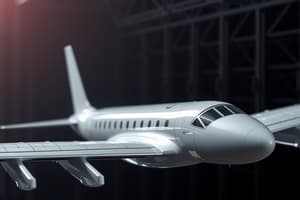Podcast
Questions and Answers
What are the three competing demands that airplane structures need to juggle?
What are the three competing demands that airplane structures need to juggle?
- Strength, Hardness, Brittleness
- Density, Melting Point, Conductivity
- Thermal Conductivity, Electrical Conductivity, Magnetic
- Utmost Safety, Lightweight Durability, Cost-Effectiveness (correct)
What does the term 'Fusibility' refer to in material properties?
What does the term 'Fusibility' refer to in material properties?
How easily a material melts when heated
Metal alloys are chosen for aircraft structures due to their exceptional strength in both pulling and pushing forces.
Metal alloys are chosen for aircraft structures due to their exceptional strength in both pulling and pushing forces.
True (A)
_____ is the resistance to scratching or indentation in materials.
_____ is the resistance to scratching or indentation in materials.
What are the competing demands that airplane structures must juggle?
What are the competing demands that airplane structures must juggle?
Define 'Mechanical Properties' of materials in the context of airplane structure.
Define 'Mechanical Properties' of materials in the context of airplane structure.
Metal alloys are only used in pulling forces in aircraft structures.
Metal alloys are only used in pulling forces in aircraft structures.
______ are the workhorses of aircraft structures, chosen for their exceptional strength in both pulling and pushing forces.
______ are the workhorses of aircraft structures, chosen for their exceptional strength in both pulling and pushing forces.
Match the following composites with their common applications:
Match the following composites with their common applications:
Flashcards are hidden until you start studying
Study Notes
Aircraft Structure Demands
- Aircraft structures must balance three competing demands: utmost safety, lightweight durability, and cost-effectiveness.
Properties of Materials
Physical Properties
- Density
- Melting point
- Conductivity
- Thermal expansion
Mechanical Properties
- Strength: resistance to force
- Hardness: resistance to scratching or indentation
- Brittleness: tendency to break without significant bending
- Toughness: ability to absorb impact
- Plasticity: permanent deformation under small forces
- Elasticity: ability to return to original shape after a load is removed
- Stiffness: resistance to bending under pressure
- Malleability: ability to be flattened into thin sheets
- Ductility: ability to be drawn into thin wires
- Compressive Strength: ability to withstand pushing or squeezing forces
- Tensile Strength: ability to withstand pulling or stretching forces
- Durability: resistance to wear, tear, weather, and corrosion
Common Material Used
- Material Properties: inherent to the material itself (e.g., strength, weight) and independent of its shape
- Structural Properties: depend on both the material and the design (shape) of the structure
- Manufacturing Processes: influenced by the material's properties
Interconnected Aspects
- Changing one aspect can affect the others: material, design, and manufacturing processes
Materials and Their Characteristics
Metal Alloys
- Exceptional strength in both pulling and pushing forces
- Examples: Aluminum Alloys, Steel Alloys, Titanium Alloys
Composites
- Combine multiple materials to create something greater than the sum of its parts
- Examples: Glass Fiber Composites, Carbon Fiber Composites, Aramid and Kevlar Composites, Fiber Metal Laminates (FMLs)
Aircraft Structure Demands
- Aircraft structures must balance three competing demands: utmost safety, lightweight durability, and cost-effectiveness.
Properties of Materials
Physical Properties
- Density
- Melting point
- Conductivity
- Thermal expansion
Mechanical Properties
- Strength: resistance to force
- Hardness: resistance to scratching or indentation
- Brittleness: tendency to break without significant bending
- Toughness: ability to absorb impact
- Plasticity: permanent deformation under small forces
- Elasticity: ability to return to original shape after a load is removed
- Stiffness: resistance to bending under pressure
- Malleability: ability to be flattened into thin sheets
- Ductility: ability to be drawn into thin wires
- Compressive Strength: ability to withstand pushing or squeezing forces
- Tensile Strength: ability to withstand pulling or stretching forces
- Durability: resistance to wear, tear, weather, and corrosion
Common Material Used
- Material Properties: inherent to the material itself (e.g., strength, weight) and independent of its shape
- Structural Properties: depend on both the material and the design (shape) of the structure
- Manufacturing Processes: influenced by the material's properties
Interconnected Aspects
- Changing one aspect can affect the others: material, design, and manufacturing processes
Materials and Their Characteristics
Metal Alloys
- Exceptional strength in both pulling and pushing forces
- Examples: Aluminum Alloys, Steel Alloys, Titanium Alloys
Composites
- Combine multiple materials to create something greater than the sum of its parts
- Examples: Glass Fiber Composites, Carbon Fiber Composites, Aramid and Kevlar Composites, Fiber Metal Laminates (FMLs)
Studying That Suits You
Use AI to generate personalized quizzes and flashcards to suit your learning preferences.




